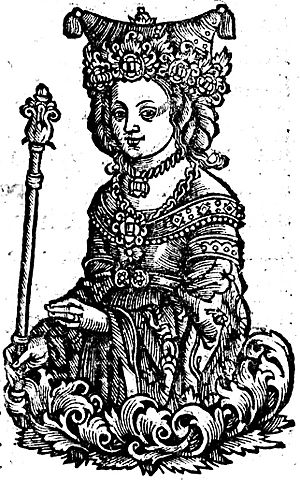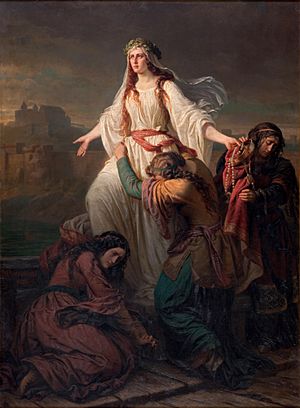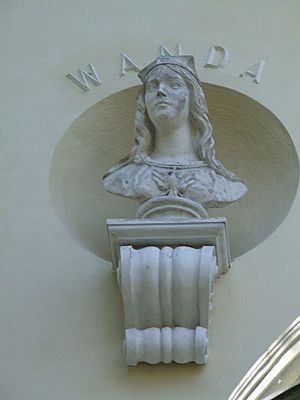Princess Wanda facts for kids
Quick facts for kids
Princess Wanda
|
|
|---|---|
 |
|
Princess Wanda is a famous figure from Polish legends. People believe she lived in the 8th century in Poland. She was the daughter of Krakus, who is said to have founded the city of Kraków. After her father passed away, Wanda became the queen of the Polish people. The legends say she made a big sacrifice to protect her land from a German ruler.
Contents
The Legend of Princess Wanda
The very first time the story of Princess Wanda was written down was by a Polish historian named Wincenty Kadłubek. This was a long time ago, in the 12th or 13th century.
In Kadłubek's version, Wanda ruled Poland after the legendary King Krakus. An "Alamann tyrant" (a German leader) invaded her lands. He wanted to take advantage because the previous ruler had died.
Wanda bravely led her army to meet the invaders. When the German soldiers saw how beautiful she was, they refused to fight. Their leader was so upset that he took his own life. In this story, Wanda lived a long and happy life and never married. Kadłubek also wrote that the river Vandalus was named after her. This is why the people she ruled were called "Vandals".
Different Versions of the Story
Over time, the story of Princess Wanda changed quite a bit. In a later version from the Wielkopolska Chronicle, the German leader was named Rytygier (Rüdiger). He first wanted to marry Wanda. When she said no, he invaded her lands.
Rytygier died during the battle that followed. In this version, Wanda then made a great sacrifice. She did this to thank the pagan gods for giving her victory.
Other versions of the story say that Wanda ended her life for another reason. She knew that as long as she was alive, other rulers would try to marry her. They might use her refusal as an excuse to invade Poland.
Where Did the Story Come From?
Most historians believe that the story of Princess Wanda was created by Wincenty Kadłubek. He might have based it on old Slavic myths and legends. Some historians also think parts of the legend could come from Scandinavian or Ancient Roman stories.
In Kadłubek's original story, the German prince died, not Princess Wanda. He wrote that Wanda lived a long and happy life and stayed unmarried. It was only in the 13th or 14th century, in the Wielkopolska Chronicle, that the version where Wanda dies became popular. This version was later spread by the 15th-century historian, Jan Długosz.
Wanda's Legacy Today
People believe that Princess Wanda is buried in a large mound called the Wanda Mound (Polish: Kopiec Wandy). This mound is located on the edge of Kraków, in an area called Nowa Huta.
Up until the 1800s, people used to light bonfires on this mound during a holiday called Pentecost. The industrial district of Nowa Huta was started on Wanda's name day (June 23). Because of this, she is seen as a special protector of the district. There is a trade center, a street, a bridge, and a stadium all named after her there.
The story of Wanda has also inspired many artists and writers. A German poet named Zacharias Werner wrote a play called Wanda. It was even performed on stage in 1809, thanks to his friend Goethe.
In Polish literature, Wanda's story is often used to talk about Polish independence. It shows a strong Poland winning against invaders. The Polish poet C.K. Norwid visited the Wanda Mound in 1840. He then wrote a long poem called Wanda to honor the ancient princess.
A Serbian writer named Matija Ban also used Wanda as a symbol of Poland. He did this in his 1868 play, Wanda, the Polish Queen.
The famous composer Antonín Dvořák created an opera called Vanda in 1875. This opera tells Wanda's story as a struggle between the pagan Slavs and the Christian Germans.
In 1890, a statue was placed on top of the Wanda Mound. It was designed by the Polish artist Jan Matejko. The statue shows an eagle looking towards the west. On the base, the name WANDA is carved, along with two swords and a distaff (a tool for spinning wool).
Scholars Albina Kruszewska and Marion Coleman described Queen Wanda as having "the pure white chastity of Elaine, the filial devotion of Cordelia, and the iron will of Boadicea". This means they saw her as pure, devoted to her family, and very strong-willed.
See also
 In Spanish: Wanda (princesa) para niños
In Spanish: Wanda (princesa) para niños




